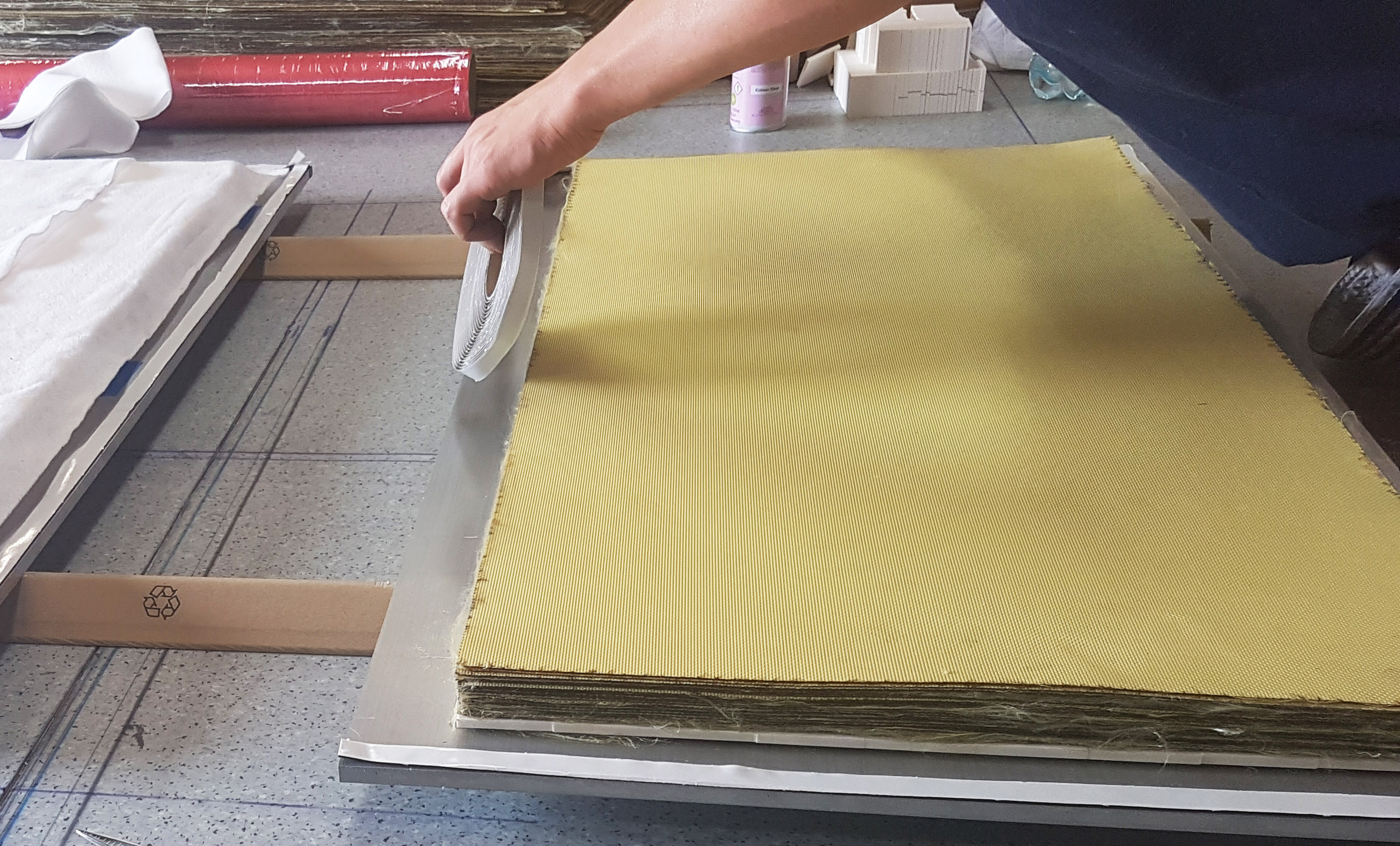
Aramid / Kevlar is a material that offers unique properties of exceptional strength and very low weight.
Although it is sometimes compared to carbon fiber there are very important differences between Aramid and carbon fiber. Actually it is not only color that differentiates Aramid from carbon fiber – Aramid is yellow whereas carbon fiber is black. Both these materials offer different properties and are suited for different industry needs.
You can find out more about carbon fiber composites and their properties in the article entitled “Carbon Fiber Composites”.
This article analyses properties of Aramid fiber composites, its advantages and disadvantages, as well as practical examples of use in different industries and finished products.
History
Aramid refers to specific materials that are available under different commercial names.
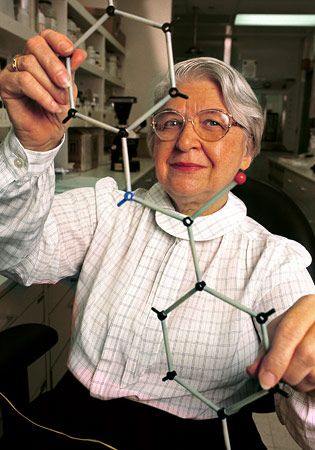
Dupont was the first company to introduce and manufacture Aramid in the 60s under the registered trademark Kevlar and it has been available on the market since 1973. Aramid was discovered by a female chemist of Polish descent, Stefania Kwolek, who conducted research focused on a low-weight and exceptionally strong material to be used instead of nylon in the manufacture of tires.
Nowadays Kevlar is the best known of all Aramid composites.
As time went by, other companies also launched production and began to supply Aramid with slightly different characteristics but similar main properties.
Aramid is supplied by other suppliers also under various commercial names including: Nomex supplied by Dupont, Twaron and Technora supplied by Teijin in Japan, Arawin supplied by Toray in Korea, Kolon supplied by Heracron in Korea, as well as some others supplied by Chinese companies.
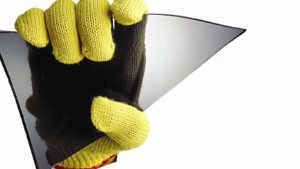
Any material named Kevlar, Twaron or Nomex actually refers to Aramid and features exceptional properties including extraordinary resistance to impact and abrasion, resistance to high temperature, as well as low weight. Thanks to these properties this material is regularly used by army, air force, water and motor sports, as well as for manufacture of tires, clothing and protective gloves and many other uses. The number of applications grows every year.
What are the properties of Aramid/Kevlar?
Aramid in the form Kevlar or Nomex refers to a structural material that offers some advantages and disadvantages. The following description covers the essential properties of Aramid composites and aramid dry fibers.
Advantages of Aramid composites
High resistance to impact and cracking
Aramid features extraordinary resistance to impact and it does not crack under pressure as it is tough and allows significant energy absorption. It is widely used for manufacture of bulletproof vests, boats, kayaks, as well as armor of components in military vehicles.
Composite made from Aramid has 5 times greater resistance to impact than a carbon fiber composite (test drop weight impact). Such extraordinary resistance to impact or bullets is as a result of long chains of atoms that form the structure of Aramid.
Thanks to these properties this material is widely used for military purposes in the manufacture of bulletproof vests and tank armor material.
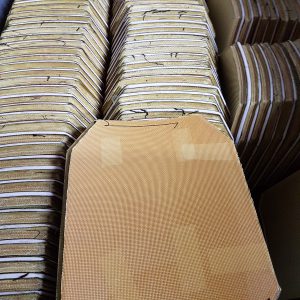
Bulletproof vests are made from material consisting of several dozen layers of Aramid (for instance Kevlar) and include a ceramic plate between the layers. Shields used in some armored vehicles such as the US M1 tank are made from material whose structure includes steel -aramid – steel to protect against anti-tank missiles up to 700mm diameter. Furthermore in addition to protection for the tank itself, the steel-aramid-steel armor shields also protect the crew by absorbing kinetic energy generated by the penetrating missile.
Another application of Kevlar is in the Boeing AH-64 – the U.S. army primary attack helicopter provided with Kevlar rotors. Here Kevlar ensures protection against bullets up to 23 mm diameter.
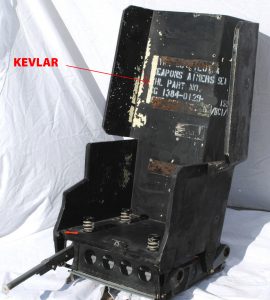
Thanks to high resistance to impact, Kevlar is widely used for building boats and kayaks, e.g. hulls of yachts designed for the Volvo Ocean Race, one of the toughest sporting challenges. Most high performance kayaks for water sports are made from Kevlar or carbon fiber/Kevlar hybrids.
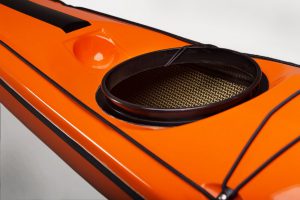
Low density /low weight
Aramid fibers feature an extremely low weight, which is an advantage during manufacture of composites.
Aramid composites are about 20% lighter than carbon fiber composites, which themselves are considered very light. Use of Aramid fabrics in composites increases resistance to impact and abrasion, as well as providing reduced weight of composite elements.
Aramid fibers have density ~ 1.45 g/cm3 whereas Aramid composites of aramid and epoxy resin have density ~ 1.3 g/cm3. This calculation was based on the density of epoxy resin mixed with hardener ~1.1 g/cm3 as well as an advanced technology employed during production of composite, namely prepreg with autoclave.
To compare carbon fibers that are considered very light, they have density of carbon composites – carbon fiber and epoxy resin equivalent to 1.55 g/cm3.
In other words Aramid fiber composites are about 20% lighter than carbon fiber composites.
How about comparing the weight of Aramid composites with metals?
Aramid composites have a density of 1.3 g/cm3. In case of aluminum it is 2.7g/cm3, titanium is 4.5 g/cm3 and steel is 7.9 g/cm3.
In other words Aramid composites are 2 times lighter than aluminum, and 3 or 4 times lighter than titanium and as much as 6 times lighter than steel.
Moderate stiffness – fill the gap between glass fiber and carbon fiber
Aramid composites have higher stiffness higher than glass fiber composites and significantly lower than carbon fiber composites.
There are many types of fibers including carbon and aramid ones – e.g. of standard, moderate and high modules that offer different stiffness, strength and available at different prices. The table below specifies the stiffness of particular fibers: glass fiber, carbon fiber and aramid fiber. Young’s modulus measurement followed in longitudinal direction.
Stiffness of different composite fibers:
- Glass fiber fabrics – from 72 GPa (Standard E-glass) to 87 GPa (S–Glass fabrics of increased strength).
- Carbon fiber fabrics – from 230 GPa (standard fabrics used for manufacture composite – Toray T300 ) up to 590 GPa (HM class Toray M60J).
- Aramid fiber fabrics – from 96 GPa (standard Aramid fabrics applied in composites – namely Kevlar 129) up to – 186 GPa (Aramid fabrics namely Kevlar 149 used in the Aircraft /Aerospace Industry).
To sum up we can conclude that Aramid composites made from standard fabrics feature stiffness about 30-40% higher than glass fiber composites and significantly limited performance compared with carbon fiber composite – which offers stiffness 50% less than carbon fiber composites.
Low thermal expansion
Aramid is very stable when exposed to high temperatures with almost zero and slightly negative thermal expansion coefficient that is equivalent to (-2.4 x 10-6/°C).
Non-conductive
Aramid is a good insulator and does not conduct electricity.
Resistance to abrasion
Aramid composites are widely used for parts and components exposed to abrasion e.g. a skid plate protecting the engine in a racing car.
Aramid is commonly used by the extraction industry (e.g. mining industry) for reinforcement of conveyor rubberized belts, and ensures higher strength and resistance to abrasion, which according to the Kevlar manufacturer may be improved as much as 50-70%.
Thanks to these properties, the material is used in composites as well as in working clothing e.g. cut resistant safety gloves where Aramid fabrics are used e.g. Twaron or Kevlar.
Vibration absorption
One specific property of Aramid composites relates to vibration absorption and consequently Aramid is used for the manufacture of components exposed to vibration e.g. aircraft structural components.
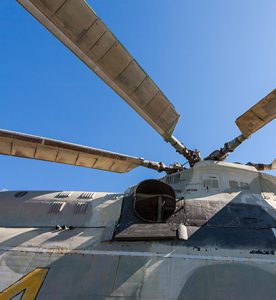
Low Dielectric Constant
Aramid composite has low electric permittivity of ~3.85 (10 GHz) which ensures good performance and strength of signal penetrating aramid protective casings /aerial radomes. This type of antenna is widely used for military purposes e.g. on military aircraft. Aramid casings/radomes protect antennas against damage and ensure good signal performance.
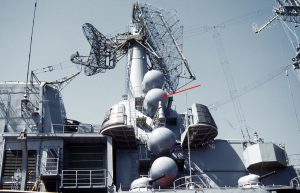
By comparison, E-glass fiber composite offers electric permittivity corresponding to 6.1 (10 GHz) which results in antenna signal power and performance 60% lower.
In addition to Aramid, quartz fabrics are also used which offer electric permittivity of 3.78 (10 GHz).
Use with other fabrics and creation of hybrid composites
Aramid fabrics may be used in carbon fiber composites and glass ones by modifying parameters according to requirements, which provides many possibilities for suppliers of composite products.
In the case of carbon fiber composites you can improve impact resistance by adding a few layers of aramid fabrics.
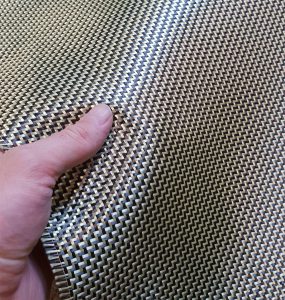
Hybrid composite made from a combination of fabrics, namely 50% of carbon fibers and 50% of aramid ones, offers 100-125% improved impact resistance compared with composites made only of carbon fiber.
Other examples of applications are a few layers of aramid provided in places where drilling follows to ensure reinforcement and reduce risk of composite damage/cracking around holes during operation or as a result of vibration.
Disadvantages of Aramid composites
Water/moisture absorbency
Aramid fibers have relatively high moisture absorbency (up to 6% of its weight) therefore Aramid composites need to be appropriately protected – usually with a top coat to reduce moisture absorbency. Additionally in the case of composites exposed to contact with water, some types of Aramid are used that have reduced water absorbency e.g. Kevlar 149 or Armos.
It is interesting to note that standard Aramid fabrics have such high absorbency and these properties provide protection against burning and scalding. This material is very often used during pyrotechnic performances, when it is soaked with paraffin. Thanks to its unique properties, Aramid ensures absorption of paraffin but does not degrade during burning and is resistant to high temperature.
To improve resistance to moisture and microcracking of aramid composite top surface, very often a layer of glass fabric is added to improve the adhesion bond of top coats and facilitate any top coat repairs in future.
Difficult treatment and processing
Aramid fibers are difficult to cut. Therefore the production process of composites including aramid fabrics can prove to be a very demanding process. Consequently it is difficult to cut both dry aramid fabrics and finished aramid composite made from aramid fabrics and e.g. epoxy resins.
Cutting of dry fabrics is possible using laser or special cutters designed for this purpose. Cutting of finished Aramid composites is possible with water jet cutting or cutters with specially designed carbide tipped or diamond tools. Note that use of cutters causes slightly frayed composite edges.
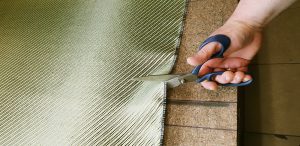
During production of Aramid composites, as early as at design phase, some changes and modifications are made to adapt molds appropriately and reduce the amount of cutting required after demolding. Sometimes, at places where cutting is required, a layer including hybrid fabrics is provided, namely one including carbon fibers (50%) and aramid fibers (50%).
Aramid fibers have modest bonding comparing to glass fibers or carbon fibers and modest resin penetration. Therefore for production of aramid composites it is recommended to use epoxy resins that offer better performance for bonding of aramid fabric layers.
UV related degradation
Aramid fibers have poor resistance to UV.
UV radiation (sunlight) causes degradation of aramid fibers. Therefore protection is required which can be a top coat or material layer e.g. aramid lines are usually enclosed in a protective covering.
High costs
Aramid is a costly material with a price similar to carbon fiber. Therefore it is used for specific purposes where extraordinary resistance to impact/abrasion is required as well as low weight of the finished product. Actually 1 sqm of finished prepreg of weight 200 g/m2 intended for production of composite is about 30-40 EUR per sqm.
Low compression strength
Aramid fibers offer compression strength lower than glass fibers or carbon fibers, therefore hybrid fabrics are widely used in components exposed to high compression, such as a structure including a combination of aramid and carbon fiber.
Aramid use
In practice aramid finds many applications. Here are some examples:
Use of Aramid in composites – Aramid composites:
- Bullet-proof vests.
- Motor sports and protection of components exposed to abrasion / impact– e.g. wheel arches, skid plates.
- Aircraft body (often carbon-Kevlar hybrid), rotors, plating.
- Airplane luggage compartments.
- Military aircraft radomes that have specific dielectric properties.
- Surfing boards.
- Kayaks.
- Ship hulls.
- LPG cylinders – weight is 70% lower than steel ones and offer improved resistance to impacts compared with carbon fiber – e.g. Low8.
Use of Aramid in dry fabric:
- Protective clothing – including flame resistant clothing, such as military clothing (e.g. a2cu ), fire service clothing, or clothing designed for F1 and NASCAR (mostly Nomex).
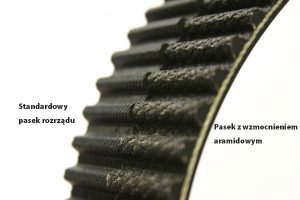
Kevlar strengthening of timing belts increases their durability and reduces the risk of breakage. - Cut resistant safety gloves.
- Rubberized components reinforcement e.g. timing belts.
- Tire reinforcement.
- Ropes.
- Optical cables provided with aramid fiber lining that prevents cracking and protects against momentary contact with fire.
- Sail cloth.
- Drumheads.
- Aramid paper used in honeycomb.
Summary
Aramid offers extraordinary properties and performance with regard to resistance to impact, abrasion, cutting and ultra-low weight that is 20% lower than carbon fiber.
At the same time this material exhibits some disadvantages such as difficult treatment and processing or moisture absorption.
We hope that reading this paper will allow everybody to learn more about the advantages and disadvantages, as well as contribute to its optimal use by engineers and designers.
MANUFACTURE OF ARAMID COMPOSITES
Dexcraft supplies aramid composite products such as bulletproof vests, racing car body components, aramid sheets and other composites.
To find out more please visit: Kevlar & Aramid parts manufacturing.

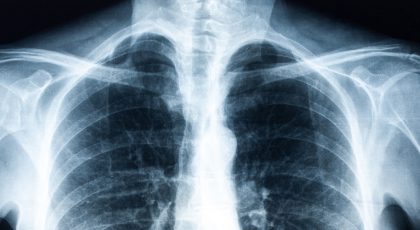
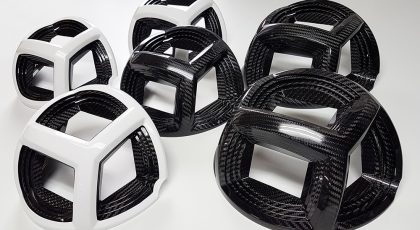
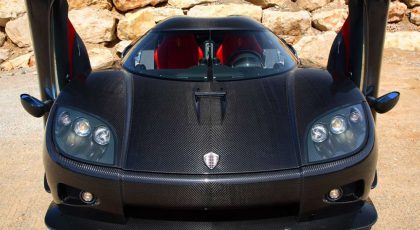
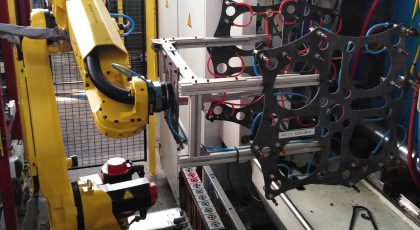
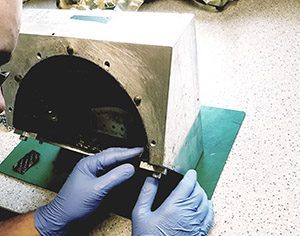
Certain critical drives demand for the Belt made up of Aramid or Kevlar® Cord, in place of the polyester cords. Kevlar® is an organic polyamide fiber which is manufactured using complex chemical processes. It is generally used where the power transmission requirements are very critical, apart from space restrictions on the permissible installation and take up allowances